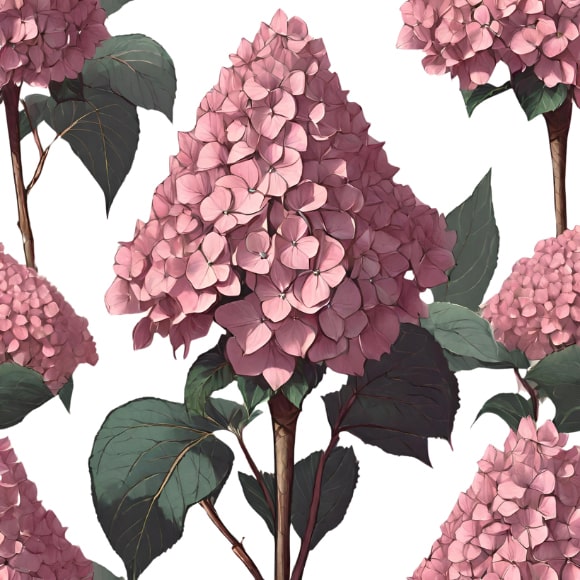
Overview
Gatsby Pink Hydrangea, a cultivar of the oakleaf hydrangea, is a captivating deciduous shrub celebrated for its stunning panicles of pink flowers, distinctive oak-like leaves, and elegant form. This hydrangea variety combines ornamental foliage with showy blooms, making it a sought-after choice for gardens and landscapes.
Description
Foliage
Gatsby Pink Hydrangea features large, lobed leaves reminiscent of oak tree foliage. The leaves turn shades of bronze, red, or purple in the Fall, adding seasonal interest to the landscape.
Flowers
The most distinctive feature of Gatsby Pink Hydrangea is its cone-shaped flower clusters that open in a creamy white hue and gradually transition to a beautiful pink as they mature. The long-lasting blooms provide an extended period of interest during the flowering season.
Size
This hydrangea variety typically reaches a height and width of 6 to 8 feet, forming a well-shaped and upright shrub with arching branches.
Growing Conditions
Soil pH
Gatsby Pink Hydrangea thrives in slightly acidic to slightly alkaline soil conditions. A pH range of 6.0 to 7.5 is considered ideal for optimal growth and flower development. The plant’s adaptability to various pH levels makes it versatile and suitable for different garden soils.
Sun Requirements
These hydrangeas perform best in partial shade to full sun conditions. While they can tolerate partial shade, providing ample sunlight encourages robust flowering. Planting in a location with morning sun and afternoon shade is often recommended, especially in regions with intense sunlight.
Watering
Gatsby Pink Hydrangeas appreciate consistently moist soil, and regular watering is crucial, especially during dry periods. Adequate irrigation supports the development of large and vibrant blooms. Mulching around the base of the plant helps retain soil moisture and suppress weeds.
Hardiness Zones
Gatsby Pink Hydrangea is well-suited for planting in USDA hardiness zones 5 to 9. This range covers a variety of climates, making it adaptable to both colder and milder regions. The plant’s ability to withstand a range of temperatures enhances its versatility and makes it a reliable choice for gardeners across different geographic areas.
Best Planting Time
The optimal time for planting Gatsby Pink Hydrangeas is in the Spring or Fall when temperatures are moderate. Planting during these seasons allows the shrub to establish a strong root system before facing more extreme weather conditions.
Maintenance Tips
To ensure the continued health and prolific flowering of your Gatsby Pink Hydrangea, consider the following maintenance tips.
Pruning
Pruning is generally minimal for Gatsby Pink Hydrangea. Remove any dead or damaged wood in late Winter or early Spring. Light pruning can be done after flowering to control size and shape.
Fertilization
Apply a balanced, slow-release fertilizer in Spring to support overall growth and flowering. Avoid excessive fertilization, as oakleaf hydrangeas are not heavy feeders.
Mulching
Mulch around the base of the plant with organic materials like shredded bark or compost. Mulching helps retain soil moisture, suppress weeds, and maintain a consistent soil temperature.
Winter Protection
While Gatsby Pink Hydrangeas are generally hardy, providing a layer of mulch around the base of the plant helps insulate the roots and protect them from Winter frost. Wrapping them in burlap can protect them from damage from heavy snow.
Regular Monitoring
Keep an eye on soil moisture levels, especially during hot and dry periods. Regular monitoring allows you to adjust watering practices, ensuring that the plant receives adequate hydration.
Landscaping Uses
Gatsby Pink Hydrangeas offer versatility in landscaping designs. Here are some popular uses in garden settings.
Shrub Borders
Planted as part of shrub borders, Gatsby Pink Hydrangea adds a touch of elegance with its attractive foliage and stunning flower clusters.
Woodland Gardens
Thrives in woodland settings, providing a naturalistic and woodland garden appeal.
Foundation Planting
Suitable for foundation planting, this hydrangea variety enhances the landscape near structures with its upright form and beautiful blooms.
Mixed Gardens
Combining Gatsby Pink Hydrangeas with other shrubs, perennials, and ornamental grasses creates visually appealing and dynamic mixed gardens.
Specimen Plant
Planted as a stand-alone specimen, Gatsby Pink Hydrangea draws attention with its unique leaves and captivating flowers.
Gatsby Pink Hydrangea, with its distinctive foliage and charming pink blooms, stands as an enchanting addition to gardens across a range of climates. Its adaptability and ornamental features make it a popular choice among gardeners seeking a plant that combines beauty with ease of care. By understanding its specific soil, sun, and watering requirements, gardeners can enjoy the delightful display of Gatsby Pink Hydrangea and elevate the aesthetics of their garden landscapes.


 Previous
Previous

